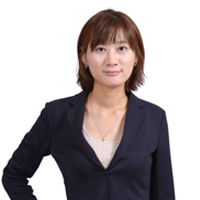Korea to open the era of space economy: Yoon
Nation aims to develop lunar lander by 2031; expand participation in Artemis
By Shin Ji-hyePublished : July 6, 2022 - 15:22

President Yoon Suk-yeol has declared that South Korea will open the era of the “space economy,” aiming to develop a lunar lander by 2031 and expand its participation in the Artemis program during his visit on Wednesday to the Korea Aerospace Research Institute in Daejeon to congratulate the second successful launch of the Nuri.
The OECD defines the space economy as the full range of activities and the use of resources that create value and benefit to human beings in exploring, researching, understanding, managing and utilizing space.
“With the successful launch of the Nuri-ho, we have become one of the world‘s seven largest space powers with satellite technology and projectile technology,” Yoon said at the event, speaking to the researchers, industry officials, and graduate students who had developed the rocket. He called the attendees “heroes of the Nuri.”
“The government will also invest boldly to open an era of the space economy,” he added.
Yoon said the nation’s future depends on the space industry, which is a key area of national competitiveness, and that the government will invest boldly to establish the Korea Aerospace Administration to systematically support the aerospace industry.
“Beyond the development of satellites and projectiles, we will actively support the development of necessary technologies in space, such as exploration robots, space transportation rights and space experiment equipment,” he said.
The president vowed to strengthen industrial competitiveness by transferring the satellite technologies and projectile technologies proven by the success of the Nuri to companies, and support space resource mining, exploration and space traffic control.
The president also said that new service industries -- such as autonomous vehicles, drones and urban air mobility -- should be in full swing through Korean-style satellite navigation systems and 6G communication satellites.
He added that by 2031, the nation aims develop a lunar lander and expand its participation in the Artemis program to realize the dream of becoming a space resource powerhouse.
The US-led Artemis is a human spaceflight program led by NASA to explore the moon, aiming for its first landing on the lunar south pole by 2025.
During talks with Yoon, KARI researchers explained their efforts and solutions to secure technologies for “thin, light and sturdy tanks” and “stable combustible liquid engines.” They also expressed the need to develop new technologies for the space economy, including space exploration.
Prior to the meeting, President Yoon visited the KARI Satellite Test Center to examine and listen to related explanations of satellites currently under development, including Korean Multi-purpose Satellite 6 and 7, for observing the Earth.
He also monitored the actual status of satellites operating in space in the control room, which operates national satellites, including the performance verification satellites that Nuri entered into space.
The OECD defines the space economy as the full range of activities and the use of resources that create value and benefit to human beings in exploring, researching, understanding, managing and utilizing space.
“With the successful launch of the Nuri-ho, we have become one of the world‘s seven largest space powers with satellite technology and projectile technology,” Yoon said at the event, speaking to the researchers, industry officials, and graduate students who had developed the rocket. He called the attendees “heroes of the Nuri.”
“The government will also invest boldly to open an era of the space economy,” he added.
Yoon said the nation’s future depends on the space industry, which is a key area of national competitiveness, and that the government will invest boldly to establish the Korea Aerospace Administration to systematically support the aerospace industry.
“Beyond the development of satellites and projectiles, we will actively support the development of necessary technologies in space, such as exploration robots, space transportation rights and space experiment equipment,” he said.
The president vowed to strengthen industrial competitiveness by transferring the satellite technologies and projectile technologies proven by the success of the Nuri to companies, and support space resource mining, exploration and space traffic control.
The president also said that new service industries -- such as autonomous vehicles, drones and urban air mobility -- should be in full swing through Korean-style satellite navigation systems and 6G communication satellites.
He added that by 2031, the nation aims develop a lunar lander and expand its participation in the Artemis program to realize the dream of becoming a space resource powerhouse.
The US-led Artemis is a human spaceflight program led by NASA to explore the moon, aiming for its first landing on the lunar south pole by 2025.
During talks with Yoon, KARI researchers explained their efforts and solutions to secure technologies for “thin, light and sturdy tanks” and “stable combustible liquid engines.” They also expressed the need to develop new technologies for the space economy, including space exploration.
Prior to the meeting, President Yoon visited the KARI Satellite Test Center to examine and listen to related explanations of satellites currently under development, including Korean Multi-purpose Satellite 6 and 7, for observing the Earth.
He also monitored the actual status of satellites operating in space in the control room, which operates national satellites, including the performance verification satellites that Nuri entered into space.





![[Exclusive] Hyundai Mobis eyes closer ties with BYD](http://res.heraldm.com/phpwas/restmb_idxmake.php?idx=644&simg=/content/image/2024/11/25/20241125050044_0.jpg&u=)
![[Herald Review] 'Gangnam B-Side' combines social realism with masterful suspense, performance](http://res.heraldm.com/phpwas/restmb_idxmake.php?idx=644&simg=/content/image/2024/11/25/20241125050072_0.jpg&u=)











![[Today’s K-pop] BTS’ Jin single hits Billboard’s Hot 100 at No. 53](http://res.heraldm.com/phpwas/restmb_idxmake.php?idx=642&simg=/content/image/2024/11/26/20241126050076_0.jpg&u=)